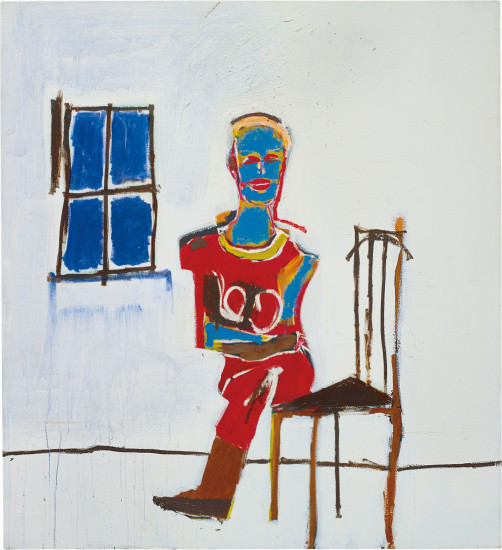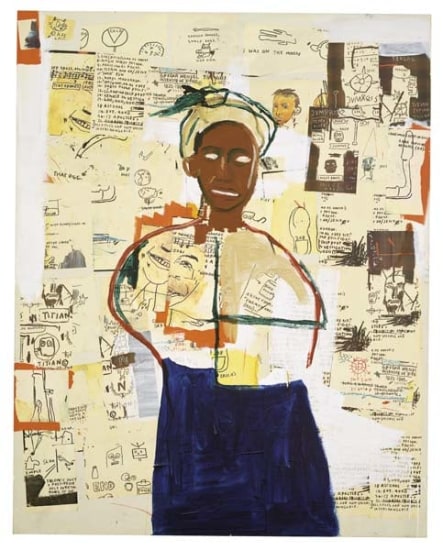Jean-Michel-Basquiat MP 1984 Acrylic and Xerox collage on canvas. 85 7/8 x 68 in. (218.1 x 172.7 cm). Signed, titled, and dated “’MP’ 1984 Basquiat” on the reverse.
Provenance Mary Boone Gallery, New York; Acquired from the above by the present owner Literature R. D. Marshall and J.L. Prat, Jean-Michel-Basquiat, Paris, 1996, 2nd ed., vol. II, p. 136, no. 1 (illustrated); R. D. Marshall and J.L. Prat, Jean-Michel-Basquiat, Paris, 2000, 3rd ed., vol. II, p. 220, no. 1 (illustrated) Catalogue Essay The wild-child of the 1980s, Jean-Michel-Basquiat’s life was a whirlwind of extremes. Putting paint on canvas for the first time in 1981, by 1983 he was an artist of rock star status. Until his untimely death from a heroin overdose in 1988, Basquiat’s output was prolific and his impact profound. It can be said that as both an artist and an individual, Basquiat “captured the downtown pulse of his time, for good and ill, and defined some key cultural crossovers. The son of Haitian and Puerto Rican parents, he embodied the emerging doctrine of multiculturalism and jumbled up various traditions with devil-may-care energy…He did not have much formal training as a painter and did not pretend otherwise, perhaps sensing that without a long apprenticeship, pretenders to the high tradition become derivative artists. Instead, he developed a distinctive, rough style that has the aura of a self-taught, sui generis outsider who lives in the middle of nowhere. Except, of course, that this smart naïf lived in the heart of the New York art world” (M. Stevens, “American Graffiti,” New York Magazine, May 21, 2005). Painted just four years before his death, MP is both emblematic of his style and evocative of the symbolism that so enraptured him. Basquiat's freshly urban and totally unique brand of intellectualized 'primitivism' was informed by a full spectrum of art historical and cultural sources: Jackson Pollock graffiti art (both modern and ancient), Pablo Picasso Jean Dubuffet the religious and cultural influences of his family background as well as the gritty urban context in which he lived and worked. The present work can be seen as a synthesis of Basquiat's diverse art historical interests and his hyper-awareness of, and emersion in his own environment. The fierceness of this painting, as well as the focus on the isolated figure at odds within its own environment recalls the rude urbanism in Dubuffet's paintings before 1950 and the totemic hieroglyphic figures of Pollock's early paintings. Both artists' raw power and defiance of traditional aesthetic norms appealed to Basquiat. The sheer energy of confrontation evident in the present work also recalls Picasso's fleshy contests between man and woman; self and other; innocence and experience. MP demonstrates Basquiat's ability as a self-taught artist who used his vast visual and cultural knowledge to create a fresh and entirely unique iconography. It is a prime example of Basquiat’s artistic expression, one “that is aggressive and rapid, yet thoughtful and literate, and which displays an expressive and intuitive control of gesture, color, and composition that is combined with provocative images and relevant subjects that are rich in reference and allusion.” (R. D. Marshall, “Foreward and Forward: Jean-Michel-Basquiat,” Basquiat, New York, 1999, p. 24). MP, like Basquiat’s other works, reveals a confluence of his numerous interests and energies, the general categories of which include his own biography, black heroes, cartoons, anatomy, graffiti, signs and symbols as well as money, racism and death. The words, in particular, describe the subjects most important to him. For, “he continually selected and injected into his works words which held charged references and meanings – particularly about his deep-rooted concerns about the creation (and abuse) of power and wealth, and the control and valuation (and exploitation) of natural resources, animals, and produce” (Richard D. Marshall in Enrico Navarra et al, Jean Michel Basquiat, Paris, 2000, p. 37). Spanning the right side of this work, next to the image of the black male figure, are Basquiat’s signature collage
Jean-Michel-Basquiat MP 1984 Acrylic and Xerox collage on canvas. 85 7/8 x 68 in. (218.1 x 172.7 cm). Signed, titled, and dated “’MP’ 1984 Basquiat” on the reverse.
Provenance Mary Boone Gallery, New York; Acquired from the above by the present owner Literature R. D. Marshall and J.L. Prat, Jean-Michel-Basquiat, Paris, 1996, 2nd ed., vol. II, p. 136, no. 1 (illustrated); R. D. Marshall and J.L. Prat, Jean-Michel-Basquiat, Paris, 2000, 3rd ed., vol. II, p. 220, no. 1 (illustrated) Catalogue Essay The wild-child of the 1980s, Jean-Michel-Basquiat’s life was a whirlwind of extremes. Putting paint on canvas for the first time in 1981, by 1983 he was an artist of rock star status. Until his untimely death from a heroin overdose in 1988, Basquiat’s output was prolific and his impact profound. It can be said that as both an artist and an individual, Basquiat “captured the downtown pulse of his time, for good and ill, and defined some key cultural crossovers. The son of Haitian and Puerto Rican parents, he embodied the emerging doctrine of multiculturalism and jumbled up various traditions with devil-may-care energy…He did not have much formal training as a painter and did not pretend otherwise, perhaps sensing that without a long apprenticeship, pretenders to the high tradition become derivative artists. Instead, he developed a distinctive, rough style that has the aura of a self-taught, sui generis outsider who lives in the middle of nowhere. Except, of course, that this smart naïf lived in the heart of the New York art world” (M. Stevens, “American Graffiti,” New York Magazine, May 21, 2005). Painted just four years before his death, MP is both emblematic of his style and evocative of the symbolism that so enraptured him. Basquiat's freshly urban and totally unique brand of intellectualized 'primitivism' was informed by a full spectrum of art historical and cultural sources: Jackson Pollock graffiti art (both modern and ancient), Pablo Picasso Jean Dubuffet the religious and cultural influences of his family background as well as the gritty urban context in which he lived and worked. The present work can be seen as a synthesis of Basquiat's diverse art historical interests and his hyper-awareness of, and emersion in his own environment. The fierceness of this painting, as well as the focus on the isolated figure at odds within its own environment recalls the rude urbanism in Dubuffet's paintings before 1950 and the totemic hieroglyphic figures of Pollock's early paintings. Both artists' raw power and defiance of traditional aesthetic norms appealed to Basquiat. The sheer energy of confrontation evident in the present work also recalls Picasso's fleshy contests between man and woman; self and other; innocence and experience. MP demonstrates Basquiat's ability as a self-taught artist who used his vast visual and cultural knowledge to create a fresh and entirely unique iconography. It is a prime example of Basquiat’s artistic expression, one “that is aggressive and rapid, yet thoughtful and literate, and which displays an expressive and intuitive control of gesture, color, and composition that is combined with provocative images and relevant subjects that are rich in reference and allusion.” (R. D. Marshall, “Foreward and Forward: Jean-Michel-Basquiat,” Basquiat, New York, 1999, p. 24). MP, like Basquiat’s other works, reveals a confluence of his numerous interests and energies, the general categories of which include his own biography, black heroes, cartoons, anatomy, graffiti, signs and symbols as well as money, racism and death. The words, in particular, describe the subjects most important to him. For, “he continually selected and injected into his works words which held charged references and meanings – particularly about his deep-rooted concerns about the creation (and abuse) of power and wealth, and the control and valuation (and exploitation) of natural resources, animals, and produce” (Richard D. Marshall in Enrico Navarra et al, Jean Michel Basquiat, Paris, 2000, p. 37). Spanning the right side of this work, next to the image of the black male figure, are Basquiat’s signature collage

.jpg)









Try LotSearch and its premium features for 7 days - without any costs!
Be notified automatically about new items in upcoming auctions.
Create an alert